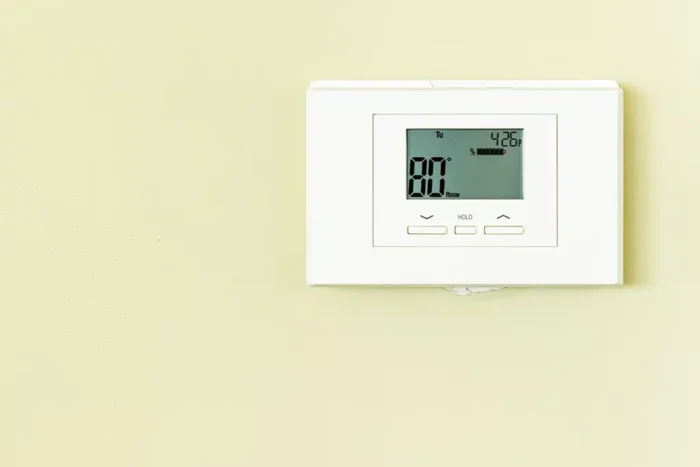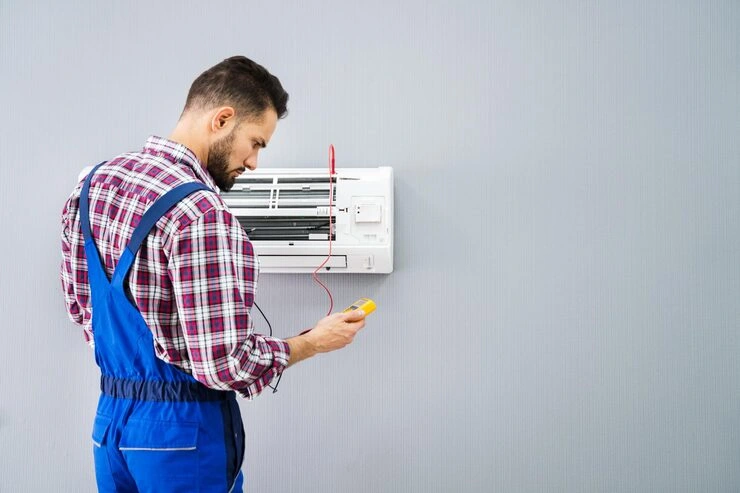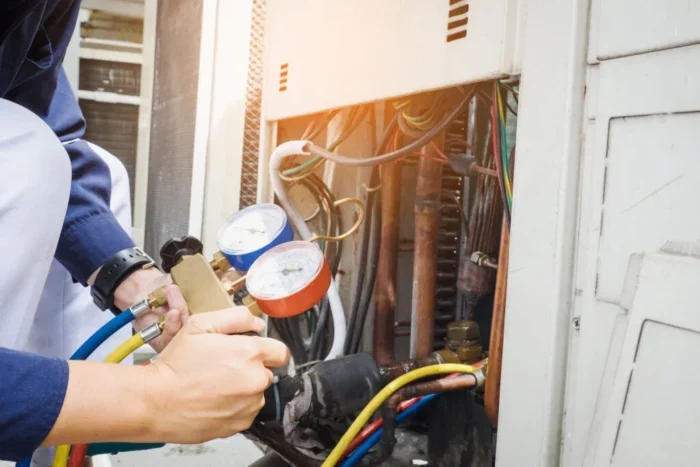Have you ever noticed a small button or switch labeled “EM Heat” on your thermostat and wondered what it does? Many homeowners feel confused when they see this setting. Understanding what is emergency heat on a thermostat can help you avoid costly mistakes and keep your home warm during cold weather without breaking the bank.
Emergency heat is a backup heating system built into heat pumps. It kicks in when your primary heating fails or can’t keep up with extreme cold. While it sounds helpful, using it at the wrong time can send your energy bills through the roof. Let’s break down everything you need to know about this feature.
Understanding What Is Emergency Heat on a Thermostat
Emergency heat, often shown as “EM Heat” or “E-Heat” on your thermostat, is a secondary heating source in your HVAC system. This feature only exists in homes with heat pump systems. It does not appear on thermostats connected to traditional furnaces.
A heat pump works by pulling warmth from outside air and moving it inside your home. This process works great most of the time. But when temperatures drop very low or your heat pump stops working, your system needs another way to heat your home. That’s where emergency heat comes in.
The Technology Behind Emergency Heat
The emergency heat setting bypasses your heat pump completely. It switches on electric resistance heating strips inside your air handler. These strips work like a giant toaster, converting electricity directly into heat. While this method warms your home quickly, it uses much more power than your regular heat pump.
Think of emergency heat as the spare tire in your car. You only use it when your main tire fails. It gets you home safely, but you shouldn’t drive on it for long trips. The same rule applies to your heating system.
How Does EM Heat Work?
When you flip your thermostat to emergency heat mode, you’re telling your system to shut down the heat pump and rely only on backup heating. The outdoor unit stops running completely. All the heating work falls to the electric resistance strips inside your home.
The Heating Process Explained
These heating strips contain coils that get red hot when electricity flows through them. Air from your blower passes over these coils and gets heated up fast. The warm air then flows through your ducts and into your rooms.
The process is simple and direct. There’s no refrigerant cycle involved. No compressor running outside. Just pure electric heat. This simplicity makes emergency heat very reliable when you need it most.
Why Emergency Heat Uses More Energy
However, this method burns through electricity at a much higher rate than your heat pump. A heat pump can produce three units of heat for every one unit of electricity it uses. Electric resistance heating only produces one unit of heat per unit of electricity. That’s three times less efficient.
You ma read What Is The Blue Wire On A Thermostat?
Is It Appropriate to Use EM Heat?
You should only use emergency heat in true emergencies. The name tells you everything you need to know. Here are the only times you should switch to this setting:
When Your Heat Pump Fails
Your heat pump has stopped working completely. If your outdoor unit won’t turn on, makes strange noises, or the technician told you it’s broken, then use emergency heat until repairs are done.
During Extreme Cold Conditions
Extreme cold has frozen your heat pump. When temperatures drop below 25-30 degrees, ice can build up on your outdoor unit. If the defrost cycle fails and ice blocks the unit, emergency heat keeps you warm while the ice melts.
Waiting for Professional Repairs
You’re waiting for a repair technician. If your heat pump fails on a Friday night and the repair person can’t come until Monday, emergency heat keeps your family comfortable. But call for service right away.
Rare Temperature Extremes
Your heat pump can’t keep up with extreme weather. During record-breaking cold snaps, your heat pump might run constantly but still can’t reach your set temperature. In this rare case, emergency heat helps maintain comfort.
Never use emergency heat as your regular heating source. Some people think switching to EM Heat saves money or heats faster. Both ideas are wrong. Emergency heat costs more and should only run when necessary.
How EM Heat Works with Your Heat Pump
Modern HVAC systems are smart. They have multiple heating stages that work together. Understanding em heat vs heat in your system helps you see the big picture.
Stage One: Normal Heat Pump Operation
Stage one is your heat pump running normally. It pulls heat from outside air and pumps it inside. This is the most efficient way to heat your home. Your system tries to stay in this stage as much as possible.
Stage Two: Auxiliary Heat Activation
Stage two adds auxiliary heat. When outside temps drop or your home needs a quick temperature boost, small electric heating strips turn on to help your heat pump. This auxiliary heat works alongside your heat pump, not instead of it. The emh on thermostat display might show “AUX” when this happens.
Stage Three: Full Emergency Mode
Stage three is emergency heat. This stage only activates when you manually switch your thermostat to EM Heat mode. Everything else shuts off. Only the backup electric strips run. This is your last resort for heating.
The heat pump emergency system design gives you options. But those options come with different costs. Your regular heat pump is cheapest. Auxiliary heat costs more but still reasonable. Emergency heat is most expensive.
At Hutchinson Heating and Air, we help homeowners understand these systems. Our technicians explain the difference between normal operation and emergency mode during every service call.
Reasons Not to Use Emergency Heat
The biggest reason to avoid emergency heat is cost. Running on EM Heat can double or triple your electric bill. Some homeowners have seen their monthly costs jump by $200 or more when leaving emergency heat on for weeks.
High Energy Consumption
Electric resistance heating uses massive amounts of power. While your heat pump might use 3-4 kilowatts to heat your home, emergency heat can use 10-15 kilowatts or more. That difference adds up fast on your utility bill.
Equipment Wear and Damage
Another problem is wear and tear. The electric heating strips weren’t designed to run all the time. They heat up to very high temperatures. Running them constantly can burn them out faster. Replacing these strips costs money and leaves you without heat during repairs.
Indoor Air Quality Issues
Emergency heat also dries out your indoor air more than regular heating. The strips get much hotter than your heat pump’s output. This super-hot air pulls moisture from your home, making everyone uncomfortable. Dry air can cause static shocks, dry skin, and respiratory issues.
Environmental Impact
Your carbon footprint grows when using emergency heat too. Most electricity comes from power plants that burn fossil fuels. Using three times more electricity means three times more emissions. Regular heat pump operation is much greener.
Using Emergency Heat on Your Thermostat May Result In
Switching to the em heat setting on your thermostat triggers several changes in your home. Being aware of these effects helps you monitor your system properly.
Dramatic Energy Cost Increases
Your energy bills will spike dramatically. Expect to see costs increase by 100-300% compared to normal heating months. If you usually pay $150 for heating, emergency heat could push that to $450 or more. Track your daily usage if your utility offers online monitoring.
Different Air Temperature Output
The temperature of air coming from your vents will feel different. Emergency heat produces much hotter air than your heat pump. This might seem good at first, but it can make rooms feel stuffy. The dry, hot air also circulates differently through your home.
Silent Outdoor Unit Operation
Your outdoor unit will sit silent. Unlike normal operation where you hear the outdoor fan and compressor, emergency heat keeps everything outside turned off. Some people worry their system is broken when they don’t hear outside noises. But if you’re on EM Heat, this silence is normal.
Electrical System Strain
Your circuit breaker might trip more often. Emergency heat draws so much power that it can overload your electrical panel if other large appliances run at the same time. Avoid running your dryer, electric oven, or space heaters while on emergency heat.
Slower Heating Response
You might notice your home takes longer to reach your set temperature. Even though emergency heat feels hotter, it might not heat your whole house as quickly as your heat pump with auxiliary heat. This happens because the heating strips are in one location while your heat pump circulates heat more evenly.
When to Call a Professional
If your thermostat keeps showing emergency heat when you didn’t switch it there, something is wrong. This usually means your heat pump has failed and your thermostat automatically switched to backup mode. Call for service immediately.
Warning Signs That Need Attention
Strange smells when running emergency heat need attention too. A slight burning smell is normal the first time you use it each season. But strong chemical odors or smoke mean something is overheating. Turn off your system and call for help.
Unexplained Cost Increases
Rising energy bills without explanation deserve investigation. If you haven’t changed your thermostat settings but your bills keep climbing, your system might be running on auxiliary or emergency heat too often. A technician can diagnose why.
Persistent Ice Problems
Ice buildup that won’t melt indicates a problem. Your heat pump should defrost itself automatically. If ice keeps building up and your system keeps running on emergency heat, the defrost cycle needs repair.
At Hutchinson Heating and Air, we respond quickly to heating emergencies. Our team can diagnose heat pump problems and get you back on efficient heating fast. We serve homeowners throughout the area with honest service and fair pricing.
Conclusion
Knowing what is emergency heat on a thermostat helps you use your HVAC system wisely. This backup heating keeps you warm during true emergencies but costs much more than regular heating. Only switch to EM Heat when your heat pump fails or during extreme cold. Always call for professional repairs as soon as possible. Understanding the difference between normal heat pump operation, auxiliary heat, and emergency mode protects both your comfort and your wallet.
Ready to get your heat pump running efficiently again? Contact Hutchinson Heating and Air today for expert HVAC Services in Murrieta you can trust!
FAQs
Should I turn on emergency heat during a cold snap?
Only if your heat pump completely fails. Your system will automatically add auxiliary heat when needed during cold weather. Manual emergency heat should only be used when the heat pump stops working.
How much does emergency heat cost compared to regular heating?
Emergency heat typically costs 2-3 times more than normal heat pump operation. A $100 heating bill could jump to $200-300 when running on EM Heat for the full month.
Can I damage my system by using emergency heat?
Extended use can wear out the heating strips faster than normal, but occasional emergency use won’t cause damage. The bigger risk is to your wallet from high electric bills.
Why does my thermostat say auxiliary heat instead of emergency heat?
Auxiliary heat is automatic backup that works with your heat pump. Emergency heat is manual backup that replaces your heat pump. Auxiliary heat is normal and much more efficient.
How long can I safely run emergency heat?
You can run emergency heat as long as needed during an emergency. However, call for repairs within 24-48 hours to avoid extended high costs and potential equipment wear.







